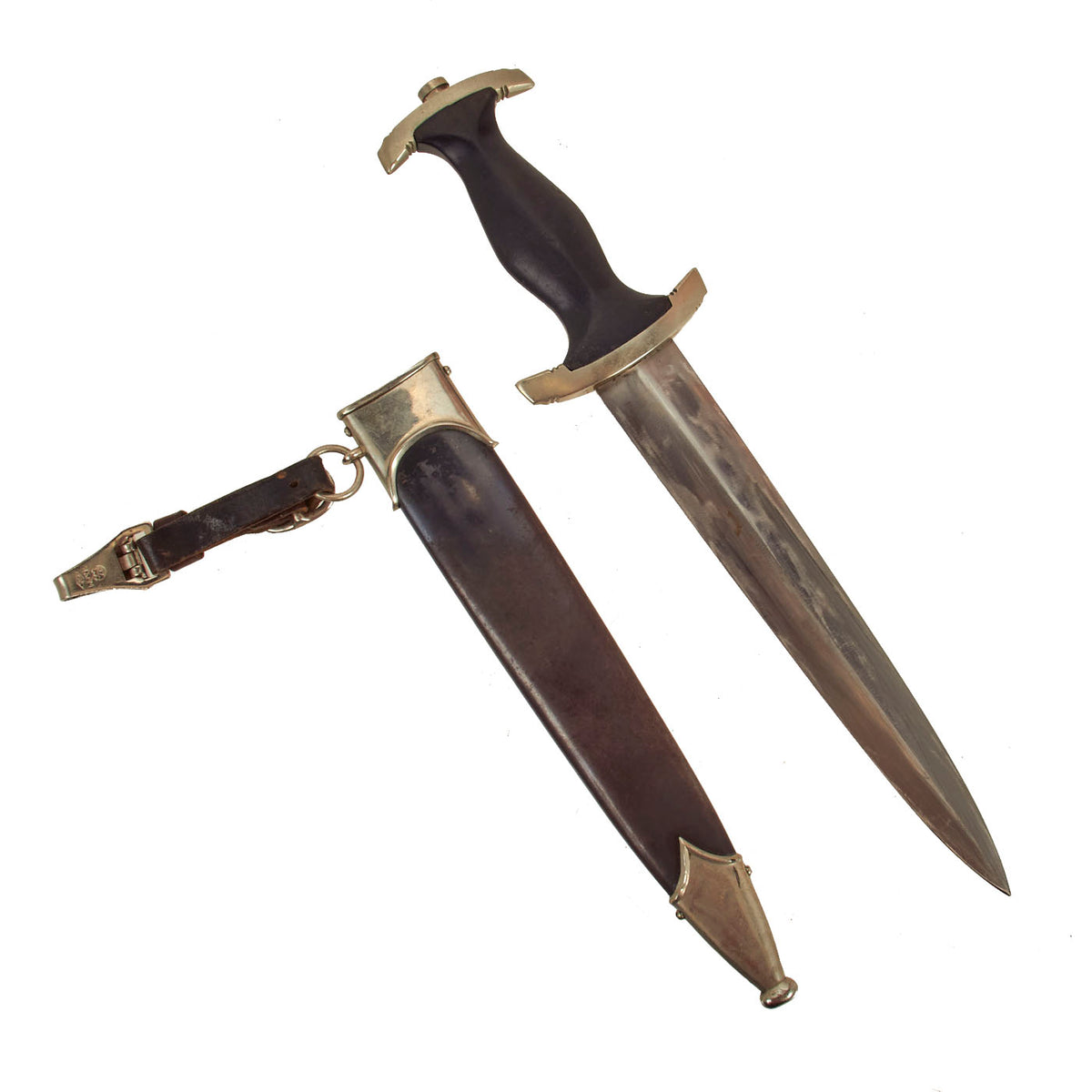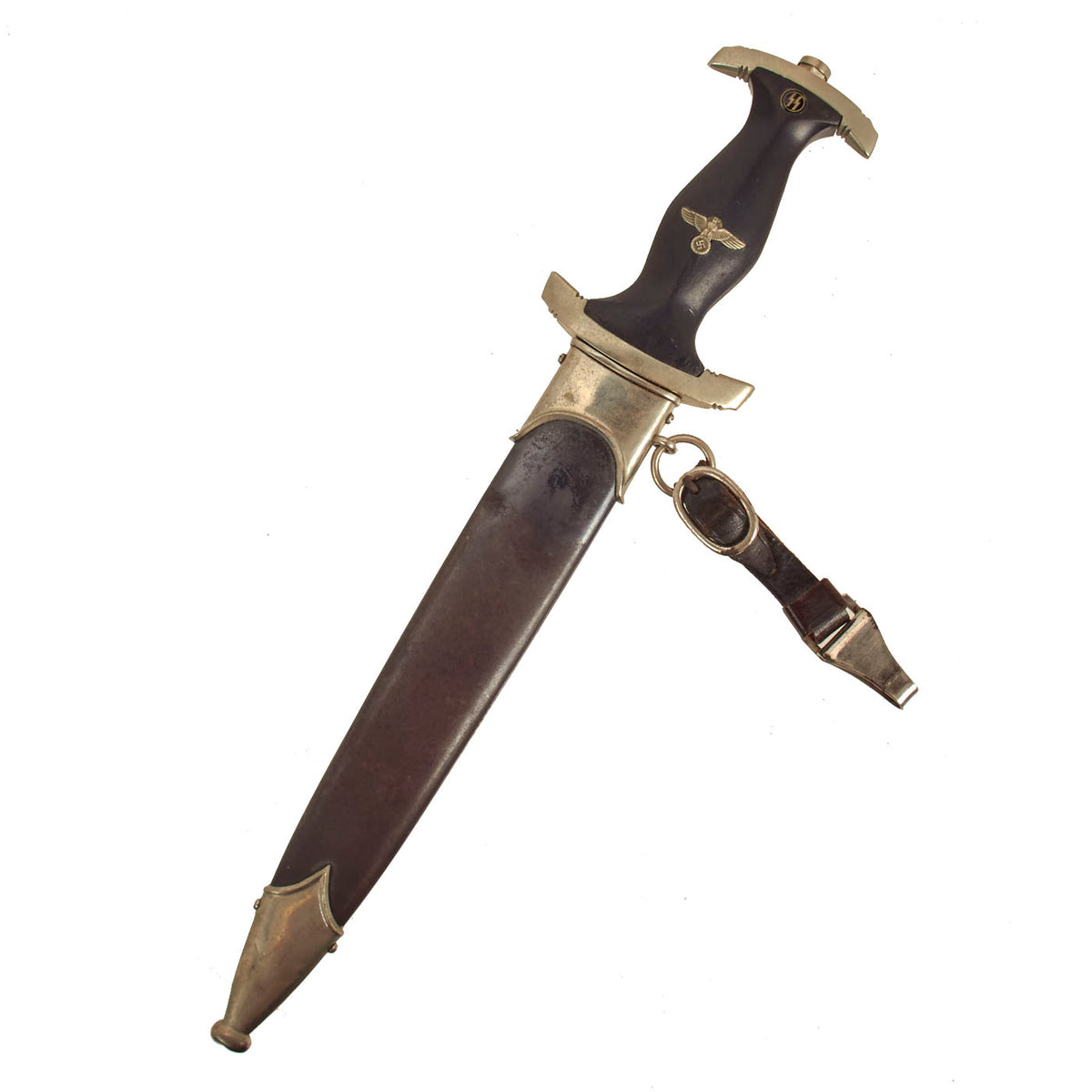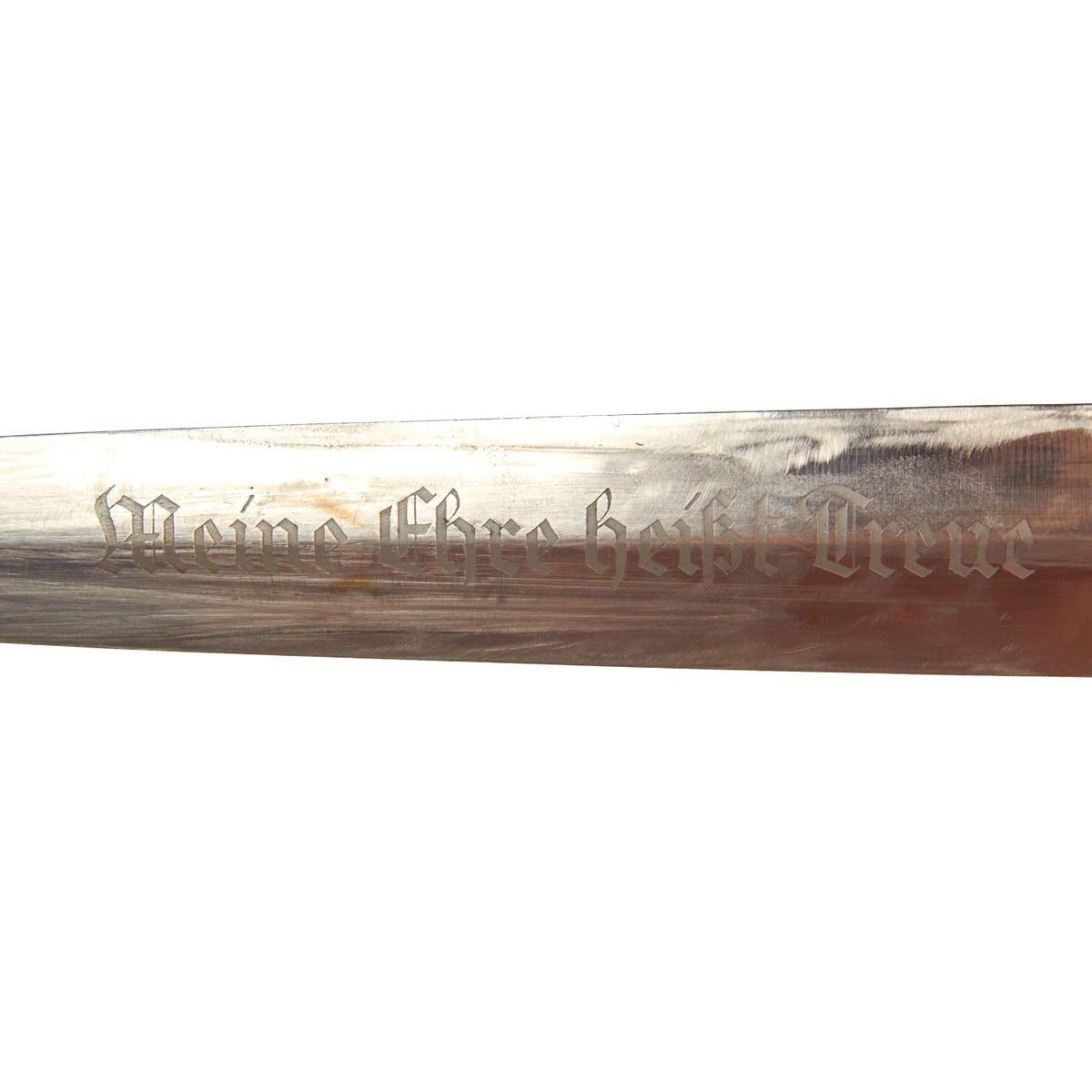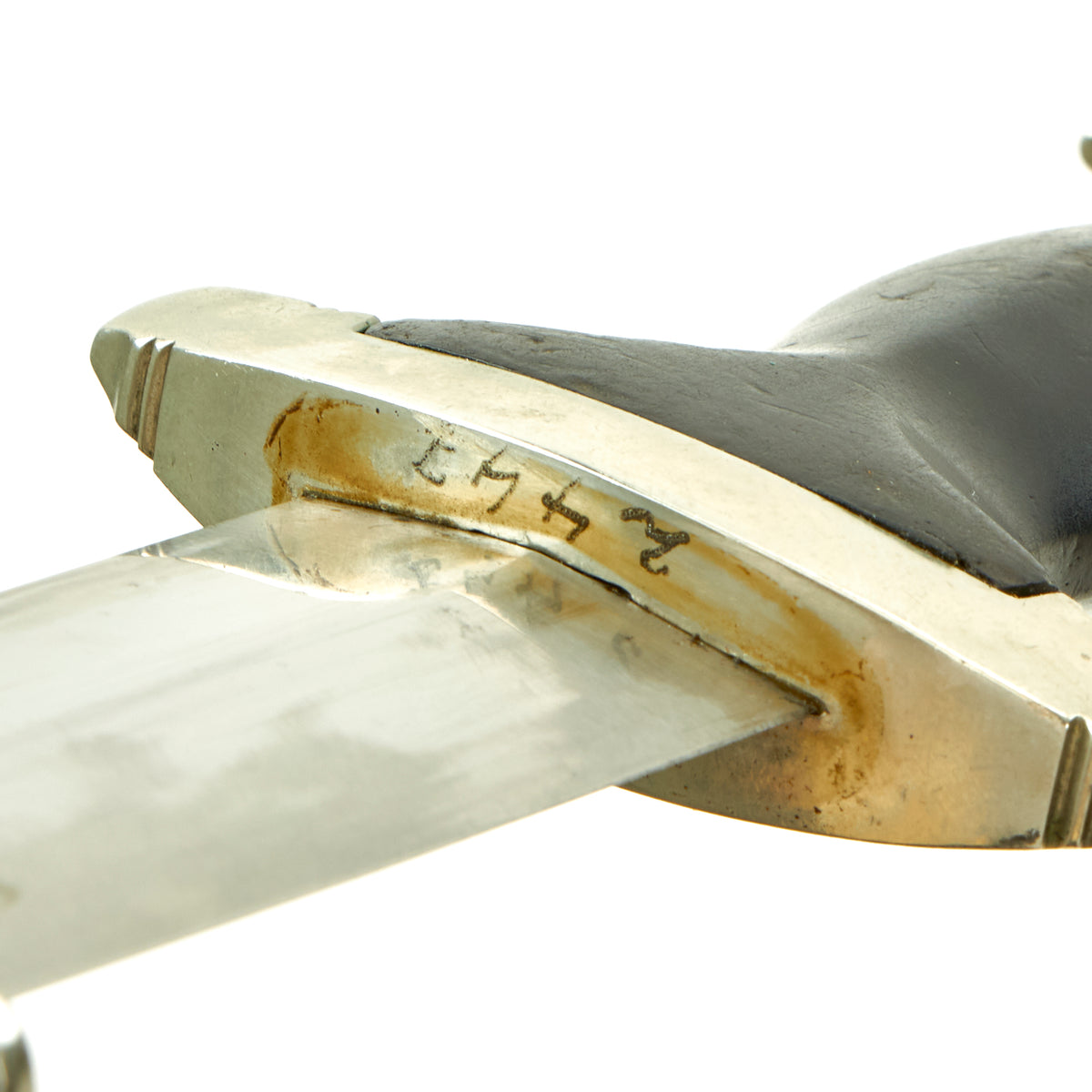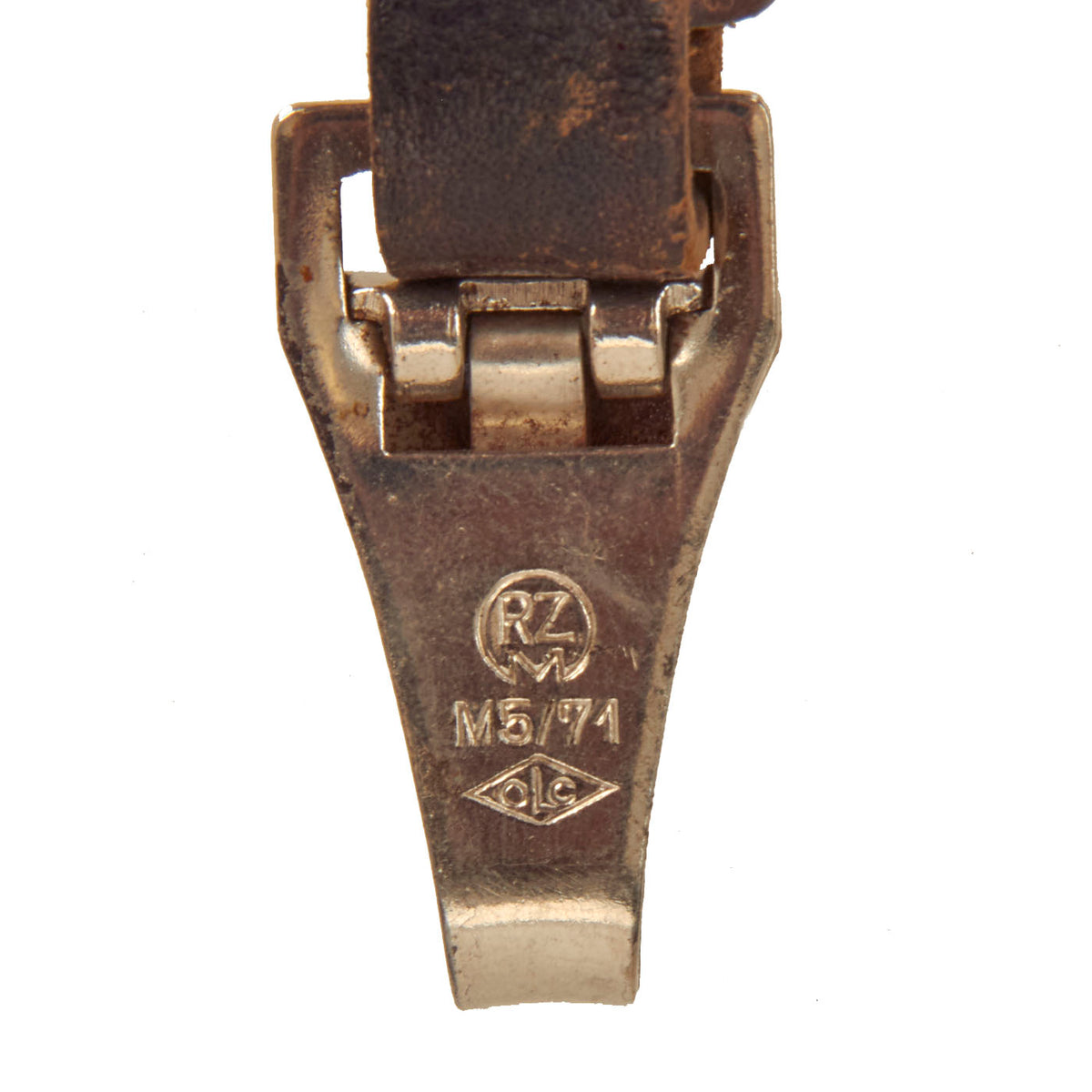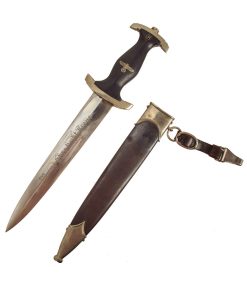Original German WWII Early Possible Ground Röhm Signature Numbered M33 SS Dagger with Scabbard & Belt Hanger Original Items
$ 3.500,00 $ 875,00
Original Item: Only One Available: Prior to his “unmasking” as a traitor, Ernst Röhm was the leader of the Sturmabteilung (SA). In 1934, he distributed approximately 100,000 SA daggers with his personal inscription on the reverse blade. This was etched into the blade, and read In herzlicher kameradschaft Ernst Röhm (In cordial companionship Ernst Röhm). These daggers were to honor individuals who had served with the SA prior to December, 1931. At this time, the Schutzstaffel (SS) was an Elite Unit within the SA, so longtime members were among those who received these daggers as well.
Other than the inscription, these pieces were identical to the standard M1933 SS dagger. After the Röhm purge in mid 1934, the inscription was ordered to be removed, and failure to comply would be considered treason. Some were simply ground in the field by whatever means were available. Many other examples, as we suspect this is one of, were returned to the factory for grinding and refinishing. Often, this would remove the maker logo as well, as on this example, which now has a completely blank reverse. Examples will occasionally be encountered with remnants of the original inscription remaining on the blade, but mostly none will remain. Some blades exist with an intact inscription, exhibiting only the removal of the Röhm signature. Very, very rarely is an example seen with a full, untouched inscription, as the holder would have surely risked a charge of treason.
The SS (Schutzstaffel) was originally formed in 1925, ostensibly to act as a small, loyal bodyguard unit to protect the Führer, Adolf AH. Under the direction of the Reichsführer-SS Heinrich Himmler, the SS grew to be the most ruthless and feared organization of the 20th century. They were the vanguard of the NSDAP organization, and eventually controlled nearly every function of German life and much of Occupied Europe. The SS dagger was introduced in 1933. Early on, members of the SS were awarded their daggers during a ceremony at the Feldherrnhalle Memorial in Munich. The annual ritual, charged with mysticism and meant to evoke the traditions of medieval Teutonic knights, was held on 9 November, the date of the unsuccessful Munich Putsch of 1923. Both officers and enlisted men wore the identical dagger until 1936. After this time, only enlisted men wore the M1933 dagger.
The SS Dagger was equipped with nickel crossguards with an ebony wood grip. The black grip contained a National eagle with swas insignia recessed in the center area and an SS sigrunne button inset at the top. On early examples the scabbard shell surface was factory blackened using a metal bluing process. The scabbard had nickel mounts. The SS blade was a polished type containing the SS motto, Meine Ehre Heißt Treue (My Honor is Loyalty). Early examples were mostly hand-fit. Production of later examples was more standardized, using cheaper, nickel-plated fittings with black painted scabbard shells. They could be held with a standard belt hanger, or a much rarer vertical hanger.
The blade on this example is actually in really good condition, the best we have seen on an SS dagger for quite some time. The factory final grind markings on the obverse are still present in many areas, especially near the ricasso. This texture is iconic, and is the definitive identifying characteristic for a real WWII German Blade. The rear is in a similar condition, however close examination of the spine shows that material was definitely removed, and then it was reground at the factory, showing much of that same final grind crossgrain.
We believe the rear was reprofiled and ground because it was originally issued with the inscription “In Herzlicher Freundschaft Ernst Röhm” (In heartfelt friendship Ernst Röhm) on the back. It was then returned to the factory, where almost the entire rear of the blade was re-ground, removing the etched signature and maker marking. The acid etched SS motto on the front, Meine Ehre heißt Treue (‘My honor is loyalty’) is clear with just a bit of the factory darkening left. The edge of the blade does not show any sharpening after the original factory grind, and is still in good condition. OVerall the blade does show signs of polishing and runner wear, but it really presents great.
The crossguards of this dagger and tang nut are in very good condition throughout, and are of the earliest solid nickel silver construction. They have matured to a lovely lightly worn and oxidized patina, with no lifting or bubbling, confirming they are solid alloy. There is no district marking on the crossguard, however it is marked on the top with number 2447, which could potentially be a great research opportunity. Per a customer request, we removed the handle, and both the crossguard and pommel guard are stamped P A on the interior.
The ebony grip on this example, unlike like most seen today, is still in very good condition, with just the tiniest bit of flaking next to the pommel guard on the reverse. The treatment used on these grips makes them quite brittle, so they crack quite easily, and Ebony is also known for cracking somewhat easily, which makes this really a great example. There are some pressure dents, but nothing out of the ordinary for a dagger used in service. The silvered ᛋᛋ doppelte Siegrune (Double Sig/Victory Rune) symbol and double circles are in great shape, with intact plating and enamel, showing some verdigris on the right side. The nickel grip eagle is the “high-necked” type with the beak pointing slightly up, still perfectly set into the wood.
The scabbard shell is a solid example being straight as an arrow with a few tiny dents. The shell originally had a black “anodized” finish, which was then lacquered to protect it. The lacquer on this example has mostly worn away, only preserved near the top locket fitting. This has also allowed the anodized finish to wear on most of the scabbard, now a gray oxidized patina. The original anodized finish is however preserved under the lacquer at the top. The matching solid nickel silver scabbard mounts are in good condition. The lower ball has been dented in, though it is not split. The weaker nickel alloy used in early models (later ones used steel) is unfortunately prone to denting. All four dome headed screws are present, and in good condition.
The attached belt hanger is in good condition, with a plated steel hanger clip, RZM marked M5/71 over olc in a diamond, for Overhoff & Cie. of Lüdenscheid, who produced numerous clothing accessories. The leather is in good condition, and the clip has a lovely lightly oxidized surface.
An excellent chance to own an early SS M33 Dagger in great shape, which is very likely a great example of a “Sanitized” ground Röhm example. Ready to display!
Specifications:
Blade Length: 8 3/4″
Overall length: 13 3/4”
Crossguard: 3”
Scabbard Length: 10”
Fast Shipping with Professional Packaging
Thanks to our longstanding association with UPS FedEx DHL, and other major international carriers, we are able to provide a range of shipping options. Our warehouse staff is expertly trained and will wrap your products according to our exact and precise specifications. Prior to shipping, your goods will be thoroughly examined and securely secured. We ship to thousands clients each day across multiple countries. This shows how we're dedicated to be the largest retailer on the internet. Warehouses and distribution centres can be located throughout Europe as well as the USA.
Note: Orders with more than one item will be assigned a processing date depending on the item.
Before shipping before shipping, we'll conduct a thorough inspection of the items you have ordered. Today, the majority of orders will be delivered within 48 hours. The delivery time will be between 3-7 days.
Returns
The stock is dynamic and we cannot completely manage it because multiple stakeholders are involved, including our factory and warehouse. So the actual stock may alter at any time. It's possible that you may not receive your order once the order has been made.
Our policy is valid for a period of 30 days. If you don't receive the product within 30 days, we are not able to issue a refund or an exchange.
You can only return an item if it is unused and in the same state as the day you received it. You must have the item in its original packaging.
Related products
Uncategorized
Armored Burgonet Helmet & Polearm from Scottish Castle Leith Hall Circa 1700 Original Items
Uncategorized
Uncategorized
Uncategorized
Uncategorized
Band of Brothers ORIGINAL GERMAN WWII Le. F.H. 18 10.5cm ARTILLERY PIECE Original Items
Uncategorized
Uncategorized
Uncategorized
Uncategorized
Armoured Fighting Vehicles of the World: AFVs of World War One (Hardcover Book) New Made Items
Uncategorized
Australian WWII Owen MK1 Machine Carbine SMG Custom Fabricated Replica with Sling Original Items
Uncategorized
Uncategorized
Uncategorized
Uncategorized
Uncategorized
Uncategorized
Uncategorized
Uncategorized
Uncategorized
Uncategorized

